spyros
Photorejuvenation
If you want to improve your skin’s texture we suggest one of the best methods to make your skin look even more beautiful. The photorejuvenation process offers a comfortable and effective phototherapy for treatment of sun damage to the skin, spider veins and other problems, greatly improving your appearance.
A treatment for many skin conditions
The Palomar photorejuvenation system uses intense pulsed light to treat:
- Photoaging: Wide areas of pigmentation on the face, neck, hands, neckline and other areas.
- Sunspots: Pigmented lesions, also known as age spots.
- Rosacea: Redness around the cheeks or nose; facial erythema.
- Spider veins: Individual vessels, which can be red, blue or purple.
Safe, comfortable and fast!
The photorejuvenation process provides the most safe, well-tolerated and effective treatment with short or zero recovery time. Sessions are quick and you may return to work or resume any other activity feeling and looking better!
OTHER TREATMENTS WITH THE USE OF PALOMAR PULSED LIGHT SYSTEM
Your doctor has chosen the Palomar pulsed light system because it offers the most versatile, effective and well-tolerated cosmetic treatments. In addition to the abovementioned photorejuvenation, skin replenishment, spider veins, sun damage (sunspots, patches, fine lines) and acne treatments, as well as skin pigmentation disorders such as Rosacea, melasma and poikiloderma, Palomar is also used for such applications as permanent hair reduction, acne clearance and firming.
3D Cryolipolysis
Fighting localized fat deposits with cryolipolysis
Thanks to the new Cryolipo II technology, localized fat that is diet and gym resistant can easily become a memory of the past with this powerful cold treatment.
Details on cryolipolysis
The new CRYOLIPO II is an advanced system for selective cryosculpture that is based on the method of cryolipolysis and achieves permanent reduction of localised fat in an absolutely safe manner. This is a non-invasive, FDA-approved method based on extensive research conducted by Harvard University on non-invasive liposculpture techniques.
How can CRYOLIPO II treat local fat both immediately and effectively? Studies have shown that if fat cells are exposed to intense cold for a specific period of time they gradually die (apoptosis). Subsequently, all destroyed fat cells are excreted via a perfectly normal process through the lymphatic system.
More specifically, the system has two very comfortable handpieces with built-in LCD displays. The handpieces are used locally on adipose tissue. Vacuum keeps the tissue within the cold chamber for a specific period of time (phase 1).
This allows intense freezing (up to -9 degrees Celsius) (Phase 2), which leads to subsequent decline of fat cells (Phase 3). However, it is very important to point out that the surrounding area remains intact, as adipose tissue is much more sensitive to the effects of cold, compared to the surrounding tissues, which are not affected during the freezing procedure.
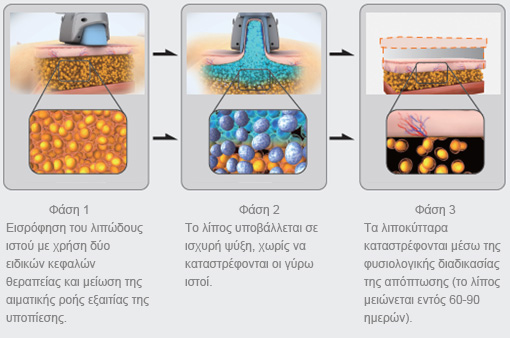
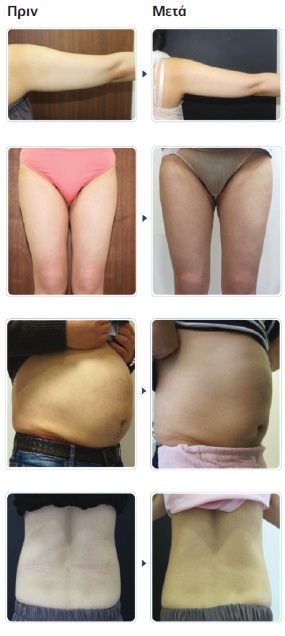
As a result of the above process, the localized fat area starts downsizing as soon as 20 days after treatment while therapeutic result is achieved within three months. Depending on the extent of the patient’s problem, treatment with CRYOLIPO II can be performed alone, or if necessary, in combination with additional treatments.
This treatment is comfortable, fast (1-hour duration) and can be applied in various areas of the body, such as the arms, back, waist, abdomen, buttocks and thighs. With zero recovery time, the patient can resume daily activities immediately after the end of treatment.
One of the many advantages of Cryolipo II that also makes this treatment unique is that the handpieces operate in a 3D mode (covering the targeted surface at 360 degrees) with patented technology. Unlike other similar equipment, Cryolipo II also has special handpieces that are appropriate for curved areas (such as buttocks, stubborn fat around the thighs, knees etc). This allows a more uniform and symmetrical outcome in fat reduction that may reach up to 30% within an hour of pain-free treatment. Other models only have two freezing rods and cannot achieve diffuse freezing. Consequently, the outcome lacks smoothness and uniformity
To sum up, the features and benefits of treatment with CRYOLIPO II, are the following:
- Non-invasive and bloodless method without use of anaesthesia
- Safe, immediately effective and fast treatment
- Causes fat cells apoptosis
- No recovery time
- Comfortable and easy treatment for both patient and operator
- Enhanced freezing mechanism (up to-9˚C)
- Strong vacuum (up to 50 kilopascal)
- Two handpieces for concurrent therapies
- Three different types of handpieces
- Built-in LCD screen on handpiece
- Unique, patented 3D technology for freezing application (360°) for a more uniform result.
- Special handpieces that can be used on more difficult curved areas such as stubborn fat, buttocks, knees, inner thighs.
Neck and face lifting
The impression that many cosmetic surgery procedures come with certain age criteria is not absolutely true. What determines whether a person - male or female - is a good candidate for a lifting procedure is, most of all, the degree of wrinkle formation, laxity and deformation of the facial contour. Age is not such a determining factor. People of the same age may age at different speeds when it comes to their facial characteristics.
A person who is about 45 years old is considered to be at a crucial age but may not develop obvious signs of aging if he/she undergoes some of the available non-invasive treatments (e.g. Bοtox, implants, Laser, care products with strong pharmaceutical agents, peeling etc.). He/she may gain valuable time and postpone surgical solutions. On the other hand, a person of the same age may need to be submitted to surgery to achieve the desired face rejuvenation result. In general, as in all fields of medicine, prevention must always be prioritised ahead of treatment for best possible results.
However, the 4th decade of a person’s life is the most crucial period to decide on face rejuvenation, since there is still time to achieve most natural results, which is our most important goal.
Endoscopic Lift
Endoscopic methods have marked a revolution in surgery during the recent 15 years. It would have been impossible, of course, not to make a grand entrance in the field of plastic surgery, where, as it is known, surgeons aim for minimum incisions, zero recovery time and optimum results.
A characteristic example is the endoscopic facelift where 5 cm long incisions are made along on the temporal region, well concealed inside the hair. The procedure is performed through there. Under general anaesthesia and with the use of a special endoscope, we first detach the surface tissues of the face above the temporal fascia, while when we move below the jugal bones the level of detachment is deeper (underneath the periosteum).
Tissue release can be further facilitated with small incisions inside the oral cavity. Relocation then follows with support of the tissues with strong absorbable stitches and wound suture. This way we can correct nasomalar grooves, laxity of the mid-face (lifting and enhancement of tissues above the jugal bones) as well as below the eyelids.
It is clear that the extent of incisions in a procedure will increase its gravity and, of course, recovery time after surgery. Therefore, in the case of endoscopic facelift incisions are very small. Since the entire procedure is performed on the deep tissues, ecchymosis is also prevented.
Moreover, an elastic bandage is used for 3 days and along with appropriate medication it may limit swelling to the minimum and help the patient resume activities very soon.
MACS Facelift
The world trend in cosmetic surgery is getting the best result with the smallest possible incisions and shorter recovery time.
M.A.C.S. Facelift is a facelift technique that honours this trend. M.A.C.S. means Minimal Access Cranial Suspension lift. It is a surgical technique performed under General Anaesthesia or Local Anaesthesia and Sedation. Incisions are made along the sideburn through the ear and from 0 to 3 - 4 cm behind the ear. The length of the incision behind the ear depends on the severity of the problem around the neck area. Ideal candidates are men and women who have developed skin laxity extending from the jowl to the neck, Although there is no particular age for a Μ.Α.C.S Facelift, we reserve this procedure for patients over the age of 40.
Facelift videos
 Facelift (live χειρουργείο) - Νέα τεχνική με καταπληκτική ανάρρωση
Facelift (live χειρουργείο) - Νέα τεχνική με καταπληκτική ανάρρωση V - MACS Facelift - Live Surgery - Keramidas Evangelos
V - MACS Facelift - Live Surgery - Keramidas Evangelos
Δείτε τη Νέα Τεχνική Facelift με καταπληκτηκή ανάρρωση
https://www.keramidasevangelos.com/press/author/31-spyros?start=210#sigProIddc660b75a2
Anticipated results of Facelift
Μ.Α.C.S Face lift corrects both the face and neck. The effectiveness of this method is based on the fact that the suspension performed on the face involves not only the skin but also the inner tissue. The inner tissue of the face is suspended with sutures and relocated slightly over the cheekbone (this is where the term “cranial suspension” comes from). This dual suspension of the face tissue grants longer-lasting results. The results last 5 to 10 years, but are also subject to other factors such as the age when the first facelift was performed, genetic predisposition, smoking, exposure to sun. Surgery lasts between 1 ½ – 2 ½ hours and the patient may return home on the same day. Bruising, if any, is limited. The patient may go out for a walk the day after the surgery. Pain is minimum or zero. The patient only has a stretching sensation on the face.
Complications of the procedure
The risks of this procedure are: - haematoma, inflammation, paresis of the facial nerve, deep venous thrombosis. It should be noted that complications are very rare, particularly with the M.A.C.S Facelift technique.
https://www.keramidasevangelos.com/press/author/31-spyros?start=210#sigProIdbe6d7fd2c2
Facial implants
Silicone implants are widely used in plastic surgery. Their most common and known use is in breast augmentation and breast lift procedures.
However, in the recent years their use has expanded towards aesthetic correction of other parts of the body (buttocks, calves) and the face with very good results. The composition of these implants is more compact compared to those used in breast plastic surgery. Their shape and size vary depending on the area on which they will be placed.
More specifically, in cosmetic surgery of the face, implants can be used in the area of the cheekbones, chin, the back of nose and lower jaw line. As you may understand implants are permanent and help enhance and highlight the areas on which they are placed offering a better-looking face contour. An alternative solution to this method used on cheekbones and lower jaw line is the placement of fat or implants. However, results are not permanent. As to the method of application, this is of course surgical and can be performed under local anaesthesia and sedation or general anaesthesia. It lasts about half an hour.
The advantages of this method are that it offers immediate and permanent results without any visible. In particular, in cases of cheekbone, chin and lower jaw line correction, incisions are made inside the mouth cavity. For correction of the back of the nose, incisions are made inside the nostrils. Through these small incisions (approximately 3-4cm) a small cavity is made just above the bone with care not to injure any nerves of the area. The cavity fits the size and shape of implant to the extent possible.
It is important that the cavity is not made larger than the size of the implant, so that it may stay in place. Also, it mustn’t be smaller than the size of the implant as it won’t be easy to place and secure the implant, causing possible extrusion of the implant towards the cavity because of the movement of the surrounding muscles. However, some rare problems may occur, such as infection and inflammation of the implant. In such case immediate extraction is necessary. Moreover, the implant may be relocated in which case surgical correction is also necessary. Nerves that pass from the area may also be injured but will usually heal.
Blepharoplasty
Blepharopolasty is one of the most common aesthetic procedures performed on the face.
Appropriate candidates for blepharoplasty
Are you fed up with looking tired even when you are not? Are you having difficulty in applying make up on your upper eyelids? Are you having vision difficulties due to excess skin on the upper eyelid? Do you have bags under you eyes that make you look older than you really are or feel? Then you are a candidate for blepharoplasty!
Upper blepharoplasty
Upper blepharoplasty treats the upper eyelid. It is performed with local anaesthesia and only lasts 20-30 minutes. With this procedure, we remove excess skin as well as fat usually from the inner side of the eyelid. The incision must be made precisely on the natural fold of the upper eyelid.
Lower blepharoplasty
Lower blepharoplasty treats the lower eyelid. There are two types of incisions. The first type is an incision inside the eyelid that allows us to avoid any external incisions. This technique is usually performed in young individuals who do not have excess skin. The limited volume of excess skin that is responsible for the “bag” formation is removed or relocated. The second technique involves an incision underneath the eyelashes, on the external surface of the eye. This incision is appropriate when skin has to be removed from the lower eyelid.
Rhinoplasty
There are two approaches in modern rhinoplasty. Open structure and closed structure rhinoplasty. Until 1970, all rhinoplasty procedures were performed with incisions inside the nose. This was the so-called closed rhinoplasty approach.
Open Structure Rhinoplasty
|
|
Open rhinoplasty became popular during the recent years. It involves an inverted V-shaped incision on the nasal columella.
The skin of the nose is elevated, and the bones and cartilage of the nose are exposed. This allows the surgeon to have best visualisation of the anatomy and pathology of the nose. |
|
Open rhinoplasty is the approach preferred for difficult rhinoplasty cases. Its advantages are
|
|
Closed rhinoplasty
The closed rhinoplasty approach involves incisions inside the nostrils.
Surgeons usually opt for this approach in simple rhinoplasty cases, particularly when they need to remove the nasal hump or achieve a slight lifting of the nasal tip.
The greatest disadvantage of closed rhinoplasty is that the surgeon does not have immediate visualization of the nose anatomy.
To counter this disadvantage, we often use the Delivery approach.
Delivery approach
This approach involves two incisions made inside the nose. It enables us to expose the lower section of the nose but not the upper section.
It is usually selected for nose tip procedures
Nose tip correction
Tip Rhinoplasty refers to the correction of problems of the nose tip, i.e.:
- Bulbous tip
- Boxy tip
- Droopy tip
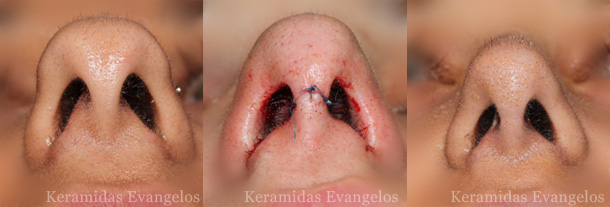 Bulbous tip - Boxy tip
Bulbous tip - Boxy tip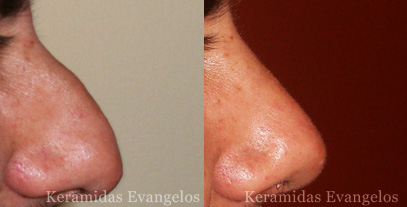 Droopy tip
Droopy tipThe nose tip is the lower third of the nose and is the most complex anatomical formation.
The slightest change on this area may cause a dramatic change on the face. This is why tip rhinoplasty is one of the most popular procedures.
Nose tip surgery may be performed through the closed, open or delivery approach.
However, because the nose tip is one of the hardest areas of the nose, surgeons opt for the delivery or the open approach.
In tip rhinoplasty we are able to change the volume, projection as well as the angles of the nose tip.
Nose tip surgery may range from very simple to very difficult.
Augmented rhinoplasty
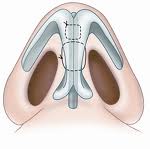
When we need to use extra material (graft) to support the nose, either for cosmetic purposes or for functioning reasons, the procedure performed on the nose is called augmented rhinoplasty.
We usually correct the projection of the nose tip by placing grafts. We may also correct the back of the nose or improve breathing.
The materials (grafts) used for nose augmentation are distinguished into artificial grafts and autografts. Most rhinoplasty surgeons, like us, opt for autologous tissues, since artificial grafts develop problems. The most popular grafts are:
- cartilage from the septum or ear
- rib graft
- fascia from the temporal fascia
In some cases, we may use a combination of these grafts.
These are the most difficult rhinoplasty procedures which are usually performed through the open approach.
Along with the grafts, we may use sutures inside the nose to change its anatomy.
Nasal septum deviation
Nasal septum deviation means that the septum of the nose has been displaced.
What is the septum?
The septum is a bone and cartilage structure dividing the two nostrils. It should generally be placed straight along the midline; nevertheless, in cases of nasal septum deviation it isn’t. 80 % of the people with deviated septum have the condition since birth or, most commonly, due to an injury.
So, is it necessary for 80% of the population who have developed septum deviation to undergo surgery? If septum is deviated but no functional problems have been developed (e.g. difficulty in breathing, sinus disorders, headaches etc.) then fixing the septum is not necessary.
It is advisable to correct the nasal septum when:
- The deviation is too big, i.e. the septum has been significantly displaced and may be responsible for various conditions such as chronic nasal congestion, headaches, breathing difficulty, snoring, paranasal sinuses disorders, face pain, frequent nose bleeding, noisy breathing (stridor) and sleep apnoea.
- When the nose is crooked on the outside and the patient wants to correct it.
- When we perform a plain rhinoplasty procedure on a big nose. If we reduce the size of the nose then the displaced septum may cause breathing problems. It is advisable to correct the septum at the same time.
Along with the septum, it is sometimes necessary to correct the conchae which are small bones on the sides of the nose.
Septum and nasal conchae correction last 45-60 min and are usually performed under general anaesthesia.
Rhinoplasty videos
Recovery after rhinoplasty
Rhinoplasty is pain-free procedure. Although it may sound strange, rhinoplasty is one of the less painful procedures.
However, there are certain things you must expect after surgery.
The nose will be covered with a small splint. A small tampon will be placed inside the nose. A small gauze will be put in front of the nose like a moustache to protect clothing from any secretion or minor bleeding. The splint will be removed in five days. In case of an open rhinoplasty, sutures will be removed in five days too. The tampon will be taken out of the nose in 16-24 hours.
You will experience some swelling and your eyes will be bruised. Swelling and bruising will last 5-14 days.
The patient is usually able to return to work in 8-14 days.
The result of the operation is visible in 2-4 weeks, but the nose will get its final shape in 6 months to 1 year.
At first, the nose will also feel blocked. However, it will slowly go back to normal. Warning: avoid blowing your nose or putting your finger inside it.
You shall take antibiotics for 5 days. You will also need to flush your nose with saline. You may take a bath on the same day. You just need to avoid bending over.
Standard rhinoplasty
A standard rhinoplasty is a surgical procedure during which we correct the nose hump and slightly enhance the projection of the nose tip. It is performed under General Anaesthesia through the closed approach and lasts about 20- 30 min.
Candidates for Rhinoplasty/Septum correction
- Nose hump
- Crooked nose
- Big nose
- Nose tip problems
- bulbous tip
- boxy tip
- droopy tip
- Difficulty in breathing
- Revision rhinoplasty
- Injury
- Cleft lip and palate
Chin surgery
Chin surgery aims at correcting the chin. This is performed either with chin augmentation or reduction.
A common aesthetic problem is the combination of small chin and big nose. In such cases, the patient is advised to undergo chin correction during rhinoplasty.
There are two methods of chin augmentation:
- If the patient has a good teeth alignment, we propose implant placement.
The operation may be combined with rhinoplasty. It lasts 30 min and consists of a small incision inside the mouth, where the gum and lower lip meet.
- If the patient has bad teeth alignment, the approach is absolutely different (cephalometric analysis and orthognathic treatment).
Revision Rhinoplasty
Secondary
Secondary rhinoplasty is performed to correct previous nose surgery.
Secondary rhinoplasty is the most complicated procedure. This is why, in such cases, most plastic surgeons use the open approach. It is advisable for secondary rhinoplasty to be performed one year after the first procedure because the cicatricial tissue will have softened and access to the nose will be easier.
Rhinoplasty complications
Complications are extremely rare
- Haemorrhage
- Inflammation
- Airway obstruction
- Septal perforation
- Saddle nose
- V deformity
- Tip deformities
- Cribriform plate fracture
Modern Rhinoplasty – Millimetre surgery
Long ago, Rhinoplasty on a person’s face was easily distinguishable. The outcome was similar since there was no variety in the nose shaping techniques.
However, this is not the case during recent years thanks to the development of open structure rhinoplasty, during which the surgeon has full visualization of the nasal anatomy and may therefore modify the nose with great accuracy and with the deployment of many different techniques (sutures, grafts etc).
Modern rhinoplasty aims at giving the patient the nose that best fits his/her face shape. Not all faces are the same. The same should apply for noses. The goal of modern rhinoplasty is to give the nose the most natural shape possible so that no one will be able to tell that the patient has undergone a surgical procedure.
This is why modern surgeons opt for the open structure rhinoplasty and use very advanced techniques such as suturing or grafting to achieve the desired result.
The Motto of modern rhinoplasty, particularly for difficult cases, is:
- Open structure reveals everything
- Grafts fix everything and
- Inside stitches change everything.
It is not by chance that open rhinoplasty is preferred by most plastic surgeons.
Neck lift
Some of the factors that lead to skin aging, with the first signs appearing on the face and neck, are chronic exposure to sun light, the stressful way of life, smoking, genetic predisposition factors and, of course, the inevitable and constant ... gravity effect.
The skin loses its elasticity, muscles weaken, wrinkles and lines appear and a generalised “tired and sad” appearance develops. The facial contour and particularly that of the lower jaw and chin loses its smoothness, while excess skin and fat gather in certain areas of the neck.
The facelift and neck lift procedures may correct the appearance of the aged face and neck. They are often performed in combination with other procedures such as liposuction around the neck, blepharoplasty, brow lift or forehead lift.
The procedure is performed under general anaesthesia or sedation and requires hospitalisation overnight. Incisions are made behind the ears and extend towards the hair and backwards and, if necessary, along the natural line in front of the ear lobe. Sometimes a very small incision also has to be made under the chin. Through these incisions, the skin is prepared and elevated from the underlying muscles and fat, which is extracted or suctioned. The muscles are then restored to their initial position with the help of sutures. Finally, after excess skin is removed, the remaining skin is stitched back with very fine sutures while incisions inside the hair are closed with clips.
Drains (very thin tubes) are usually placed through the incisions and remain in place for 24-72 hours. A head bandage is also used to prevent oedema and is removed the day after surgery.
Necklift is a very well-tolerated procedure with a relatively short recovery time. Minor oedema and bruising are expected post-operatively and subside within 10-15 days.
Possible complications are minor and rare. They may include haematoma, inflammation, temporary loss of local nerves function, scars, etc. Most patients resume their daily activities within 5-7 days and return to work 10-15 days after surgery.
Otoplasty (Ear Correction)
When the auricles are not close to the head or are larger than normal, they appear as prominent and asymmetric compared to the face and head. The procedure used to correct this deformity is called otoplasty and is usually performed on children aged up to 14 years, after their ears have fully developed until the age of 5. The otoplasty procedure is also used to correct other deformities of the auricle such as cup ear or constricted ear deformities etc. The procedure is performed under general anaesthesia on children and local anaesthesia on adults and may last 1-2 hours. A small incision is made on the back of the ear. On this spot the skin is detached from the underlying cartilage which forms the frame of the ear. The cartilage is then shaped, or part thereof is extracted, depending on the case. It is bended backwards towards the desired position and secured with non-absorbable suture. Finally, the incision is closed and dressed with appropriate elastic bandage that stays in place for a week. Oral painkillers can be taken. Stitches, if non-absorbable, are removed in 2 weeks. Adult patients resume their activities within 5 days while children need about 10 days recovery time before returning to school where they must avoid any sports activities. Oedema and bruising subside within 10-15 days. Complications are rare.



 Facelift (live χειρουργείο) - Νέα τεχνική με καταπληκτική ανάρρωση
Facelift (live χειρουργείο) - Νέα τεχνική με καταπληκτική ανάρρωση V - MACS Facelift - Live Surgery - Keramidas Evangelos
V - MACS Facelift - Live Surgery - Keramidas Evangelos 

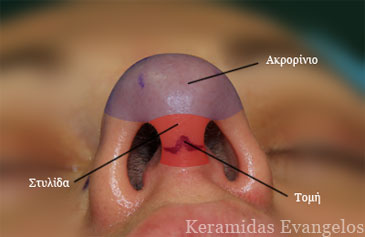
 Ρινοπλαστική βλεφαροπλαστική αυξητική στήθους
Ρινοπλαστική βλεφαροπλαστική αυξητική στήθους Ρινοπλαστική
Ρινοπλαστική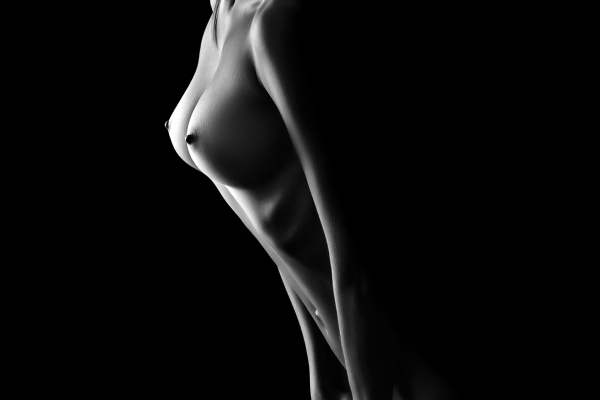

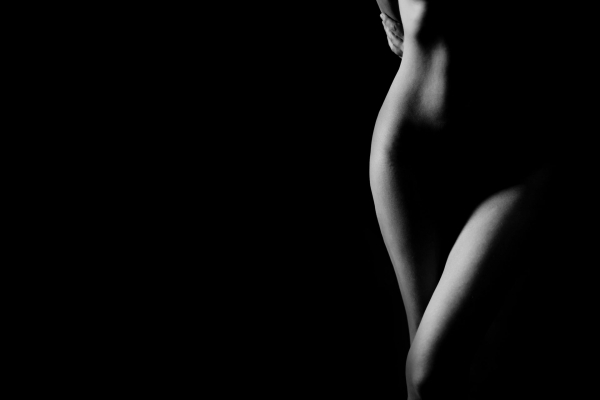

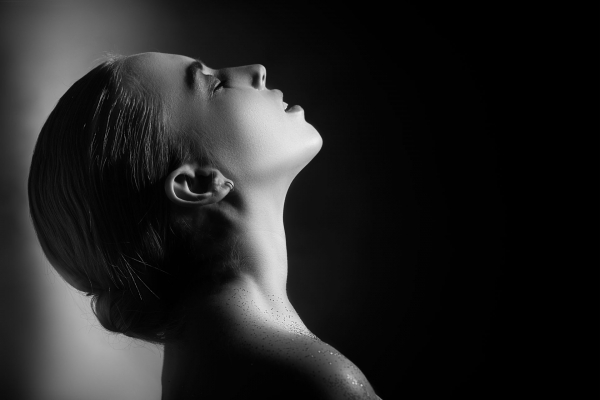




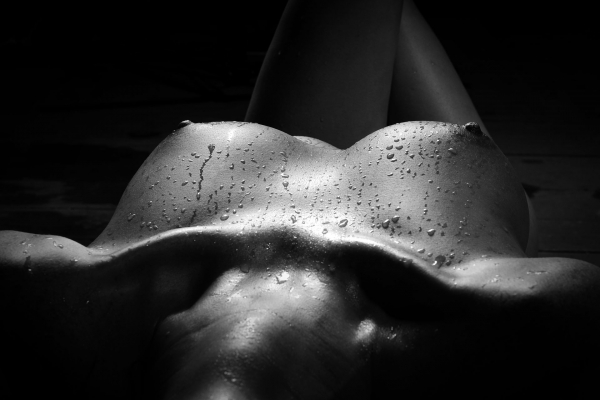



















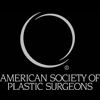
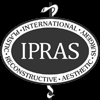
Follow us

